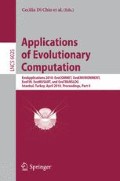Abstract
In this paper we report on the synthesis of sounds using cellular automata, specifically the multitype voter model. The mapping process adopted is based on digital signal processing analysis of automata evolutions and consists in mapping histograms onto spectrograms. The main problem of cellular automata is the difficulty of control and, consequently, sound synthesis methods based on these computational models normally present a high factor of randomness in the output. We have achieved a significant degree of control as to predict the type of sounds that we can obtain. We are able to develop a flexible sound design process with emphasis on the possibility of controlling over time the spectrum complexity.
Access this chapter
Tax calculation will be finalised at checkout
Purchases are for personal use only
Preview
Unable to display preview. Download preview PDF.
References
Burraston, D., Edmonds, E.: Cellular Automata in Generative Electronic Music and Sonic Art: A Historical and Technical Review. Digital Creativity 16, 165–185 (2005)
Chareyron, J.: Digital Synthesis of Self-Modifying Waveforms by Means of Linear Automata. Computer Music Journal 14, 25–41 (1990)
Clifford, P. and Sudbury, A.: A Model for Spatial Conflict. Biometrika. 60, 581–588 (1973)
Cox, J.T., Durrett, R.: The Stepping Stone Model: New Formulas Expose Old Myths. The Annals of Applied Probability 12, 1348–1377 (2002)
Cox, J.T., Griffeath, D.: Recent results for the stepping stone model. In: Percolation Theory and Ergodic Theory of Infinite Particle Systems. Springer, New York (1987)
Holley, R.A., Liggett, T.M.: Ergodic Theorems for Weakly Interacting Infinite Systems and the Voter Model. The Annals of Probability 3, 643–663 (1975)
Kimura, M.: Stepping-stone Model of Population. Annual Report of the National Institute of Genetics 3, 62–63 (1953)
Liggett, T.M.: Interacting Particle Systems. Springer, New York (1985)
Miranda, E.R.: At the Crossroads of Evolutionary Computation and Music: Self-Programming Synthesizers, Swarm Orchestras and the Origins of Melody. Evolutionary Computation Journal 12, 137–158 (2004)
Miranda, E.R., Biles, J.A.: Evolutionary Computer Music. Springer, London (2007)
Miranda, E.R., Wanderley, M.M.: New Digital Musical Instruments: Control and Interaction beyond de Keyboard, A-R edn., Middleton, WI (2006)
Serquera, J., Miranda, E.R.: Spectral Synthesis and Control with Cellular Automata. In: Proceedings of the International Computer Music Conference ICMC, Belfast, UK (2008)
Wolfram, S.: A New Kind of Science Online, http://www.wolframscience.com/reference/notes/876b (accessed on February, 2009)
Wolfram, S.: Computational Theory of Cellular Automata. Communications in Mathematical Physics 96, 15–57 (1984)
Author information
Authors and Affiliations
Editor information
Editors and Affiliations
Rights and permissions
Copyright information
© 2010 Springer-Verlag Berlin Heidelberg
About this paper
Cite this paper
Serquera, J., Miranda, E.R. (2010). Evolutionary Sound Synthesis: Rendering Spectrograms from Cellular Automata Histograms. In: Di Chio, C., et al. Applications of Evolutionary Computation. EvoApplications 2010. Lecture Notes in Computer Science, vol 6025. Springer, Berlin, Heidelberg. https://doi.org/10.1007/978-3-642-12242-2_39
Download citation
DOI: https://doi.org/10.1007/978-3-642-12242-2_39
Publisher Name: Springer, Berlin, Heidelberg
Print ISBN: 978-3-642-12241-5
Online ISBN: 978-3-642-12242-2
eBook Packages: Computer ScienceComputer Science (R0)

